EPANETOverviewEPANET is a calculation programdistributed by the USEPA, which uses a visual interface to model pressurizedwater distribution systems. Using this program, pipe networks (including pipes,nodes, pumps, valves, storage tanks and reservoirs) can be physically drawn inthe user interface or imported through GPS output files, AutoCAD or Google Earth.EPANET calculates hydraulic head, pressure and water quality at every junction;the flow rate, velocity headloss and average water quality though every pipe;and the hydraulic head and water quality at every tank. Outputs includecolor-coded network maps, data tables and contour plots.
Best Applications1- Complicated networks and grid systems (instead of branched systems)
- Determining what pipes and which diameters should be used
- Determining what improvements and/or extensions the network needs
- Determining where to install the tanks, valves and pumps
- Studying chlorines behavior and the necessity to establish secondary chlorination points
- Makes it possible for people with little knowledge of fluid mechanics to make decisions regarding any given network (especially useful in developing communities where professional engineers are limited)
- Widely used – there are many resources, tutorials and manuals
- Many resources are available tutorials, manuals
- Easy to find help
- Can use a programmers toolkit to run simulations and optimize the system
- Output data from all simulations can be exported to excel/text files
- Iterations can help determine where to place pressure release valves and break pressure tanks
- If you have software experience, it is easy to program your own codes
- Provides a good visual depiction of the hydraulic network
- It is easy to change one parameter (pipe length, diameter, friction…etc) and see the effects that it has on the system
- Has a user-friendly interface
- Data can but imported in several ways – the network can be drawn on user interface (a topographic map or satellite image can be imported) or data can be imported from GPS, AutoCAD and Google Earth.
- Scalability – the majority of Denver’s water system is in EPANET
- Units in EPANET may be more intuitive than other programs
- Can model various types of valves and multi-speed pumps
- Consider demand fluctuations at each node
- Can model pressure dependent flows (sprinklers, leaks, irrigation systems...etc)
- Summary output tables make it easier to check over your work
- Models system in quasi-equilibrium, as if there are no abrupt changes in the network. Epanet cannot calculate:
- Calculate water hammer
- Simulate pipe bursting
- Model the real behavior of non-return valves
- Evaluate the consequences of the presence of air inside the network
- Need to be mindful of units
- Not as adaptable as other programs
- Hides equations
- Difficulty with units when using equations for different purposes
- Difficult to optimize system without having or knowing how to use the programming tool kit
- There is no “undo” button
- Concerning water quality:
- Can determine chemical concentration at each node, but not along the pipe
- Realistic chemical reactions with contaminants may be very different than the theoretical reactions predicted with the model
- Does not include cost analysis
- Does not include a material list
- If you draw in the nodes, the map may not be to scale
PROS: - Can run different situations – when designing for developing communities there usually is plenty of water and you can design to supply a constant flow to every household. In rural communities water is generally limited and residents may have different water use patterns. You can simulate scenarios in EPANET (i.e. if all taps are off, if all taps are on, if a part of the community turns on their water at the same time…etc.) to identify areas of concern.
- Can easily use GPS data collected in the field
- Can be used in more complex systems with several loops
- Should be used in combination with other software programs – Epanet is applicable but it is also very simplified and does not take into consideration the extra variables experienced with rural communities
- Does not model surface water sources – can model with a storage tank and a flow control valve
- Assumes all pipes are pressurized and there is no air in the pipes, which is usually not the case in rural communities
- Cannot model break pressure tanks
- To save time:
- Don’t draw networks too precisely – drawing does not need to be to scale
- Don’t spend time labeling pipes and junctions with logical names – during process you will erase and add pipes
- Have a template file - input all topo data, save a copy
- Write down all changes
- Be careful on units!
- Learn the theory behind the software
- Go through user manual and tutorials
- Talk to people that have used the program
- Have patience when doing a sensitivity analysis
- For break pressure tanks:
- “Draw up actual detail drawings for each spring box and break-pressure tank and perform hand calculations to determine the hydraulic profile through these structures at the various flow rates anticipated. Given this data then you can probably “tweak” the model to make the change in the hydraulic grade line through these structures match the one developed by hand calculation methods.”
- For steep pipes (not flowing full and pressurized)
- “Use small pipe diameters which creates higher velocities for the same flow, and which will result in a head loss due to friction greater that the change in elevation. There should not be a problem in these lines if you have velocities less than 5 meters per second, and there are no sudden closing valves that could create a water hammer problem.”
- Epanet can do these calcs, but it is better to do them by hand:
- Dimensioning tanks
- Pump selection for simple pumping systems
- Estimation of energy consumption Simulation of different elements (pressure reducing valves, pressure sustaining valves)
Tutorial Many EPANET tutorials are available online. One of the best is: EPANET and Development: A Progressive 44 Exercise Workbook. 1. Arnalich, S. (2011). Epanetand development: how to calculate water networks by computer. [Almería,Spain], Arnalich, water and habitat. |
|



